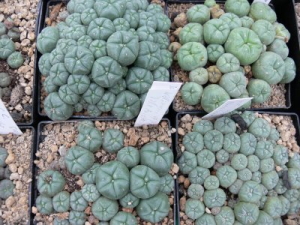Sowing
Sowing recommendation for Lophophora
To propagate the Lophophora genus, sowing is the best option.
Sowing Lophophora is relatively easy and not tied to any particular season. I prefer spring and early summer, but sowing in fall and winder is also possible with good results. Sowing according to the lunar calendar, i.e. during a full moon, can improve the germinitive rate.
Lophophora are light-induced germinators. In order to create conditions favorable for germination, three factors are required: light, water and temperature. The germinitive temperature can vary between 20°C and 30°C. Lower nighttime temperatures can be beneficial and promote germination.
The soil substrate should be absolutely sterile to prevent fungal decay after germination. If sterile soil is not available, the substrate can be heated in the microwave.
I would like to present you with my method, which I have been using for years to successfully sow Lophophora and other cacti.
The Lophophora seeds
My Lophophora seeds are fresh and thoroughly cleaned, i.e. free of pulp residue. Additional disinfecting [treatment] should therefore be omitted. The germinitive rate is generally about 80%. Disinfecting with Chinosol can prevent germination under certain circumstances.
Substrate
I use approx. 2/3 finely sifted flower-sowing soil and 1/3 washed sand. If you press this substrate firmly together in your hand and then open your hand again, it should fall apart. I use filtering gravel to cover the sowing. Filtering gravel is light-transmissive, therefore letting in sufficient light for germination of the seeds and gives the seedlings a footing for the new roots to become anchored in the substrate. Without a gravel cover, there are also a few seedlings that stretch their roots out into the air.
 |
 |
The sowing
The mixed substrate is put into a plastic pot and gently patted down. The seeds are spread evenly over the surface of the substrate and also lightly patted down, to provide good contact with the earth. About 60-100 seeds will fit into a pot that is approx. 7x7 cm. If you don’t want to transplant very soon, you should put fewer seeds in one pot. I then cover the seeds with filtering gravel the width of the gravel.
 |
 |
I place the sowing pot in tap water for about a half hour.
This amount of time is sufficient for the substrate to become penetrated with moisture.
The sowing pot is then placed in an easily sealable transparent plastic box or in a foil bag. This provides constant moisture for a rather long period of time and guarantees protection against breeding flies, which can eat up all of the seedlings in 1-2 days before you discover them.
 |
As long as condensation water forms in the container, there is sufficient moisture; if not, a bit of tap water must be added. Place the box or bag in a bright place away from the midday sun or hang it on a lamp that is turned on during the daytime hours (12 hours).
 |
It takes about 8-12 days for Lophophora to germinate.
With optimum light and temperature, the seedlings will exhibit a slightly reddish tint.
 |
 |
As soon as the seedlings are pushing against each other too much, transplanting can begin. Because of space limitations, I place the seedlings together in a larger pot without separating them out, but still in Lophophora earth. Here the seedlings can continue to spread out and strengthen, until they can finally be separated.
 |
And now, I wish you much success and enjoyment with your own growing of Lophophora.




